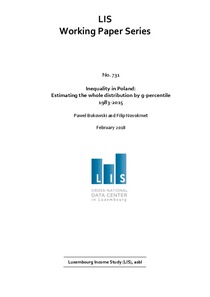Inequality in Poland: estimating the whole distribution by g-percentile 1983-2015
"This paper combines national accounts, survey and tax data to provide consistent series on income distribution in Poland over the 1983-2015 period. We find that official survey-based inequality estimates substantially underestimate the rise of inequality since the end of Communism. The top 10%...
| Main Authors: | , |
|---|---|
| Institution: | ETUI-European Trade Union Institute |
| Format: | TEXT |
| Language: | English |
| Published: |
Luxembourg
2018
LIS |
| Subjects: | |
| Online Access: | https://www.labourline.org/KENTIKA-19399580124911177629-inequality-in-Poland-estimatin.htm |
| Summary: | "This paper combines national accounts, survey and tax data to provide consistent series on income distribution in Poland over the 1983-2015 period. We find that official survey-based inequality estimates substantially underestimate the rise of inequality since the end of Communism. The top 10% income share increased from 23% to 40% and the top 1% income share from 4% to 14% between 1989 and 2015. Frequently quoted Poland’s transition success has largely benefited top income groups. Over this period, top 1% has captured almost twice as large portion of the total income growth than the bottom 50% (24% versus 13%). We also find that inequality has continued to grow after the initial upward adjustment during the transition in the 1990s, especially since the early 2000s, and today has reached levels found in more unequal European countries. However, the transition from communism to capitalism has led to lower income concentration in Poland than in Russia. We relate this to different transition policies, institutions and natural resources endowments." |
|---|---|
| Physical Description: | 27 p. Digital |

